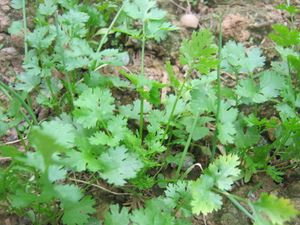Note: This is a project under development. The articles on this wiki are just being initiated and broadly incomplete. You can Help creating new pages.
Difference between revisions of "Coriandrum sativum - Dhanyaka"
(→References) |
(→External Links) |
||
| Line 61: | Line 61: | ||
==External Links== | ==External Links== | ||
| − | * [https://www.sciencedirect.com/topics/agricultural-and-biological-sciences/coriandrum-sativum] | + | * [https://www.sciencedirect.com/topics/agricultural-and-biological-sciences/coriandrum-sativum Botanical description of Coriandrum sativum in science direct] |
| − | * [http://www.alwaysayurveda.com/coriandrum-sativum/] | + | * [http://www.alwaysayurveda.com/coriandrum-sativum/ Coriandrum sativum on always ayurveda] |
| − | * [https://www.herbal-supplement-resource.com/coriander-herbs.html] | + | * [https://www.herbal-supplement-resource.com/coriander-herbs.html Coriander – Health Benefits and Side Effects] |
| − | * [http://www.flowersofindia.net/catalog/slides/Coriander.html] | + | * [http://www.flowersofindia.net/catalog/slides/Coriander.html Coriandrum sativum on flowers fo india] |
[[Category:Herbs]] | [[Category:Herbs]] | ||
Revision as of 16:07, 4 May 2018
Fruit, leaves, oil of coriander all have an important value in spices. Green freshly leaves are used to flavour and garnishing the food. Dry fruit is main ingredient in garam masala. Warm potency, unctuous, sweetish pungent, bitter in taste, remain sweetish after being digested. Its uses in global food preparation is only the tip of the iceberg. Unbeknownst to many people, coriander is packed with potential health benefits that most people completely miss when they toss this garnish into the garbage after eating their meal. It has eleven components of essential oils, six types of acids (including ascorbic acid, better known as Vitamin C), minerals and vitamins, each having a number of beneficial properties.
Contents
Uses
skin disorders, eczema, dryness, fungal infections, heart attacks, artherosclerosis, strokes, Diarrhea, Blood pressure.
Parts Used
Chemical Composition
The major volatile compounds in coriander seed essential oil were linalool, γ-terpinene, α-pinene, camphor, decanal geranyl acetate, limonene, geraniol, camphene, and D-limonene[1]
Common names
| Language | Common name |
|---|---|
| Kannada | |
| Hindi | Dhaniya |
| Malayalam | |
| Tamil | kotthu malli |
| Telugu | |
| Marathi | NA |
| Gujarathi | NA |
| Punjabi | NA |
| Kashmiri | NA |
| Sanskrit | |
| English | Coriander |
Habit
Identification
Leaf
| Kind | Shape | Feature |
|---|---|---|
| Simple | compound | Leaf arrangement is alternate and there is one leaf per node along the stem |
Flower
| Type | Size | Color and composition | Stamen | More information |
|---|---|---|---|---|
| Unisexual | 2-4cm long | pink to red | 5-20 | there are two or more ways to evenly divide the flower and there is only one way to evenly divide the flower |
Fruit
| Type | Size | Mass | Appearance | Seeds | More information |
|---|---|---|---|---|---|
| general | length is 2–6 mm | Fruit type is the fruit is dry but does not split open when ripe | With hooked hairs | {{{6}}} |
Other features
List of Ayurvedic medicine in which the herb is used
- Vishatinduka Taila as root juice extract
Where to get the saplings
Mode of Propagation
How to plant/cultivate
Grow in fertile, well drained soil in full sun where seeds are to be gathered. For leaf production partial shade is more productive[3]
Commonly seen growing in areas
Mediterranian region, meadows.
Photo Gallery
References
External Links
- Pages that are stubs
- Ayurvedic Herbs known to be helpful to treat skin disorders
- Ayurvedic Herbs known to be helpful to treat eczema
- Ayurvedic Herbs known to be helpful to treat dryness
- Ayurvedic Herbs known to be helpful to treat fungal infections
- Ayurvedic Herbs known to be helpful to treat heart attacks
- Ayurvedic Herbs known to be helpful to treat artherosclerosis
- Ayurvedic Herbs known to be helpful to treat strokes
- Ayurvedic Herbs known to be helpful to treat Diarrhea
- Ayurvedic Herbs known to be helpful to treat Blood pressure
- Herbs with Seeds used in medicine
- Herbs with Leaves used in medicine
- Herbs with common name in Hindi
- Herbs with common name in Tamil
- Herbs with common name in English
- Habit - Annual plant
- Index of Plants which can be propagated by Seeds
- Herbs that are commonly seen in the region of Mediterranian region
- Herbs that are commonly seen in the region of meadows
- Herbs



